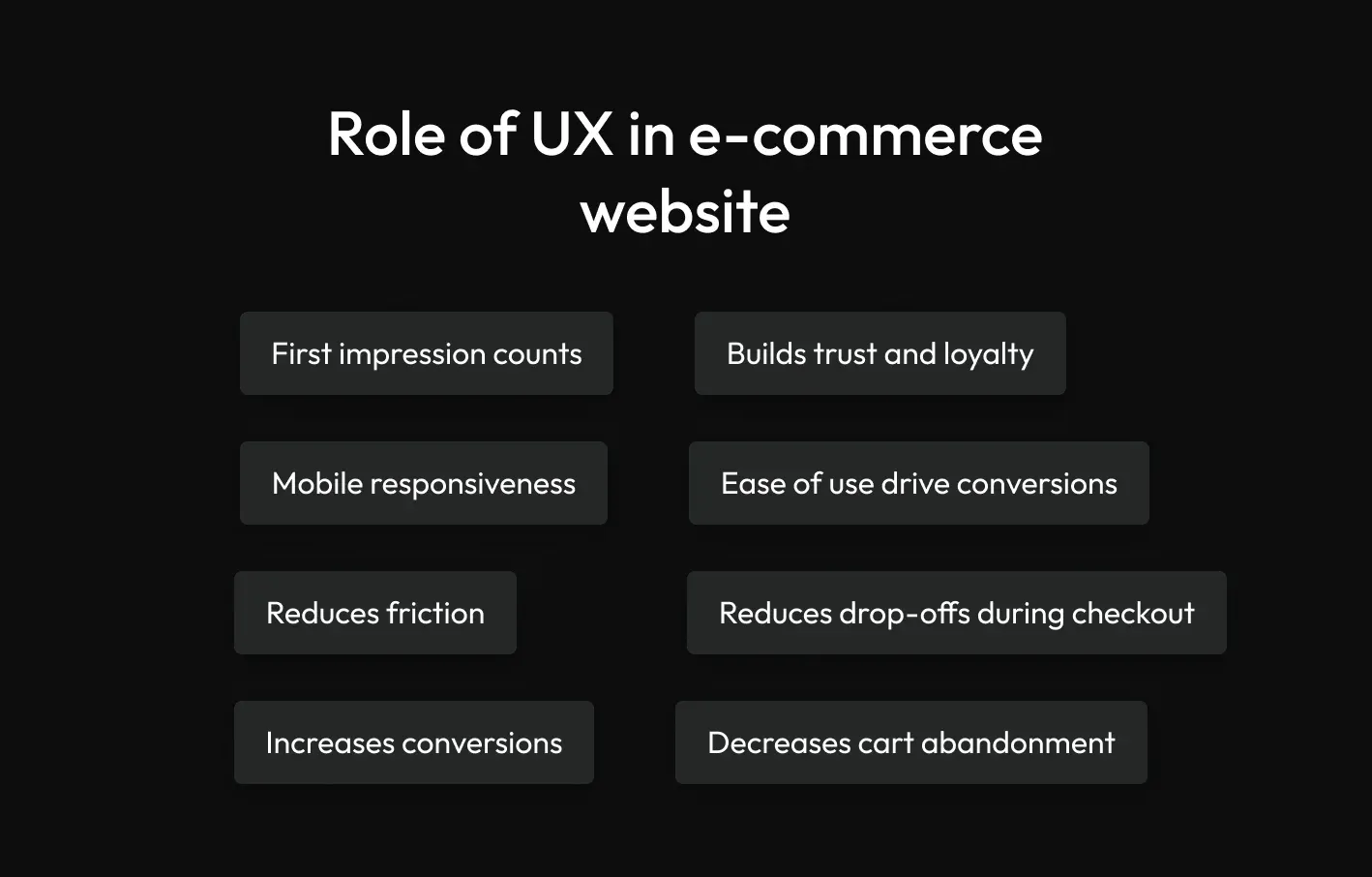Imagine stepping into a beautifully designed store where everything is meticulously arranged, the aisles are clear and spacious, and the products are neatly displayed with informative labels. As you navigate through the store, you effortlessly find what you're looking for, aided by helpful signs and friendly staff members. This seamless and delightful experience is akin to what User Experience (UX) encompasses in the digital realm. Statistics show that in the e-commerce industry, the average cart and checkout flow abandonment rate is around 70%. So, every e-commerce website needs an outstanding and intuitive UX design to resolve this concern.

Custom software development6 mins read
Prioritize UX to optimize add-to-cart and checkout flow for e-commerce website development
Posted on Aug 12, 2024

Table of contents
Share this article:
Introduction
Overview of UX in the e-commerce website
A user experience that your customer has when interacting with a product, service, or system, particularly in terms of how easy, intuitive, and enjoyable it is to use, is called the UX of a platform. In the context of online shopping, UX encompasses every touchpoint and interaction a user has with an e-commerce website or application, from browsing products to completing a purchase. Develop an intuitive and seamless cart and checkout flow for your e-commerce website by contacting the best website development company in the industry!
Now, why does UX matter for online shopping? Well, put simply, it can make or break a customer's journey from initial interest to final purchase. Here's why:

In the next section, let's discuss and explore the concerns of the cart and checkout process.
Why do users abandon the cart and the checkout process halfway?
Users may abandon shopping apps after adding items to their cart and during the checkout process due to various reasons ranging from usability issues to external factors.
⇒ Abandonment after adding items to the cart:
- Users may abandon their carts if they come across high shipping costs during the checkout process.
- If the checkout process is lengthy or complicated, users may feel discouraged from completing their purchase.
- Users may get distracted or interrupted while browsing and adding items to their carts, leading them to abandon their carts unintentionally.
- Some users use the cart as a temporary storage space for items they're considering purchasing but may ultimately choose to buy from a different retailer.
⇒ Abandonment during the checkout process
- Users may be deterred by unexpected costs such as taxes, handling fees, or additional charges that are revealed during the checkout process.
- Users may abandon their carts if they have concerns about the security of their payment information or the credibility of the website.
- Technical glitches include slow page loading times, payment processing errors, or website crashes, which will dishearten users and nudge them to abandon their carts.
- If users are required to create an account or log in before completing their purchase, it will create friction and lead to abandonment.
Read more: Which e-commerce platform suits Shopify or WooCommerce for your website development?
Importance of UX in add-to-cart and checkout flow
The stages of the add-to-cart and checkout process represent critical touchpoints in the user journey, where even minor friction points or design flaws can lead to abandoned carts and lost sales. Let's delve into why UX is paramount in optimizing these processes:
- Conversion optimization: A smooth and intuitive UX minimize friction, making it smoother for users to navigate, select products, and complete their purchases.
- Enhanced user satisfaction: A seamless and user-friendly experience leaves a positive impression on users, fostering satisfaction and loyalty, and encourages your users to return for future purchases.
- Brand perception: A well-designed add-to-cart and checkout flow conveys professionalism, trustworthiness, and reliability, enhancing the brand's perception in the eyes of users.
- Mobile optimization: Mobile users expect fast-loading pages, simplified navigation, and intuitive design elements during the add-to-cart and checkout process.
- Data-driven iteration: Analyzing user behaviour, conducting usability testing, and gathering feedback to identify pain points in the shopping cart flow is essential.
- Improved customer retention: Build long-term relationships with your customers by providing a seamless add-to-cart and checkout experience to encourage your users to return to your platform in future.
- Differentiation from competitors: Provide exceptional UX sets as a unique selling point, attracting customers who value convenience and usability during online shopping.
- Reduced customer support inquiries: A user-friendly add-to-cart and checkout flow minimizes confusion and errors, resulting in fewer customer support inquiries related to technical issues or usability concerns.
- Increased cross-selling and upselling: Strategically showcase related items or offer personalized recommendations during the shopping and checkout process to drive additional revenue.
If you are interested in learning more about how to optimize your add-to-cart and checkout flow to create a smooth user experience, then you can check out one of the best UX/UI design companies in the industry, like us. We provide in-depth insights before designing your e-commerce website for your business.
Best practice to optimize the UX of the add-to-cart and checkout flow
The add-to-cart and checkout flow in e-commerce are the most essential parts of the user experience of any online shopping platform. All your coding and designing efforts can go in vain if the users abandon your platform at the add-to-cart and checkout flow. Here are the best UX practices of e-commerce to optimize the add-to-cart and checkout flow of your platform:
- Clear CTA for add-to-cart: Use a prominent and visually appealing "add-to-cart" button that stands out on product pages. For example, the "add to cart" button on Amazon's product pages is large, brightly coloured, and strategically positioned above the fold, making it easy for users to spot and click.
- Concise cart preview: Provide a concise summary of items in the cart, including thumbnails, quantities, and prices. For example, Etsy displays a compact cart preview dropdown upon adding an item to the cart, showing thumbnails or products with quantities and prices, allowing users to quickly review their selections.
- Flexible cart management: Enable easy editing of quantities, removing items, and saving for later within the cart. For example, Shopify's cart interface includes intuitive controls for adjusting quantities, removing items, and saving items for later, all accessible with a single click or tap.
- Transparent pricing and shipping information: Clearly display detailed costs, including taxes and shipping fees, in the cart before proceeding to checkout. For example, Nike's cart page provides a breakdown of costs, including product subtotal, taxes, and shipping fees, ensuring transparency and avoiding surprises at checkout.
- User-friendly checkout flow: Implement a multi-step checkout with clear progress indicators and logical grouping information. For example, ASOS divides its checkout process into clear steps (e.g., shipping and payment) with progress indicators at the top, guiding users through each stage and reducing cognitive load.
- Minimize form fields: Only request essential information during checkout, utilizing autofill features where possible. For example, Airbnb streamlines its checkout form by only asking for necessary information, such as name, email, and payment information, minimizing friction and speeding up the process.
- Visual progress indicators: Use visual cues like progress bars or step indicators to illustrate the checkout process. For example, Walmart's checkout flow includes a progress bar at the top, clearly indicating the current step and remaining steps, helping users navigate the process with confidence.
- Trust signals and security: Display trust badges, security certifications, and accepted payment methods prominently during checkout. For example, Target prominently showcases trusted payment icons and security badges below the checkout form, reassuring users of a secure transaction environment.
- Mobile optimization: Ensure a seamless and intuitive checkout experience on mobile devices with large buttons and responsive design. For example, the mobile checkout flow on H&M's website features large, tappable buttons and streamlined form fields optimized for easy navigation on smaller screens.
- Post-purchase confirmation and support: Provide clear order confirmation messages with details such as order summary and support contact information. For example, Apple sends a detailed order confirmation email immediately after purchase, including an order summary, estimated delivery date, and customer support contact information, ensuring a smooth post-purchase experience.
Create a captivating and frictionless add-to-cart and checkout flow experience that leaves a lasting impression on your customers or visitors by weaving these elements into your e-commerce website.
Conclusion
The journey towards enhancing the UX of the checkout flow transcends mere aesthetics. It embodies a holistic approach aimed at fostering trust, minimizing friction, and amplifying user satisfaction. We can forge a path towards unparalleled success by embracing UX best practices gleaned from industry-leading sources and weaving them into our online shopping platforms. Remember, the key to unlocking the full prospect of your e-commerce shopping platform lies in the art of designing an impeccable add-to-cart and checkout UX.
Let us start the journey of transforming and empowering your users with seamless and gratifying shopping experiences. Contact us today!
Related services

Subscribe and keep updated
Get weekly update about our product on your email, no spam guaranteed we promise ✌️








